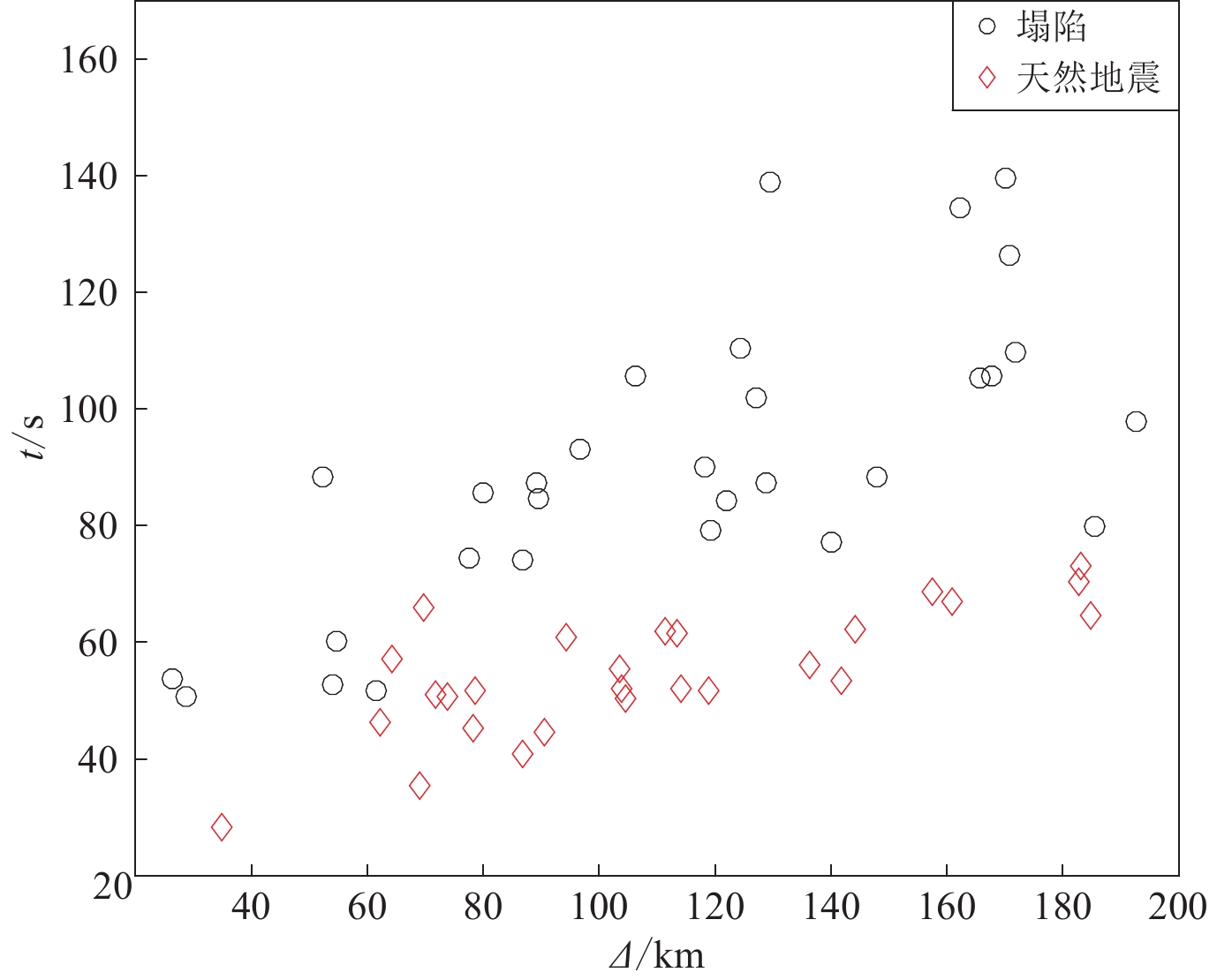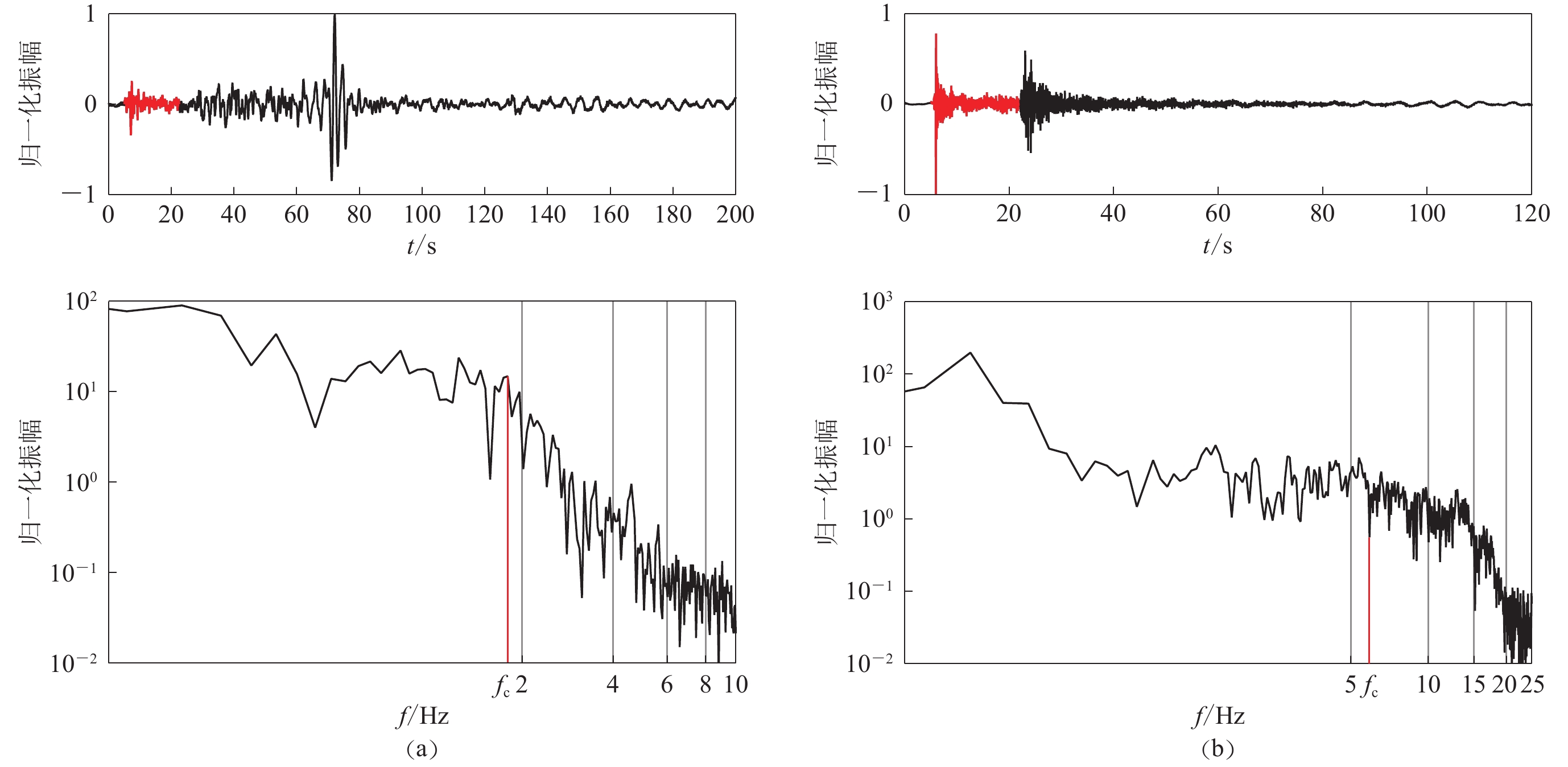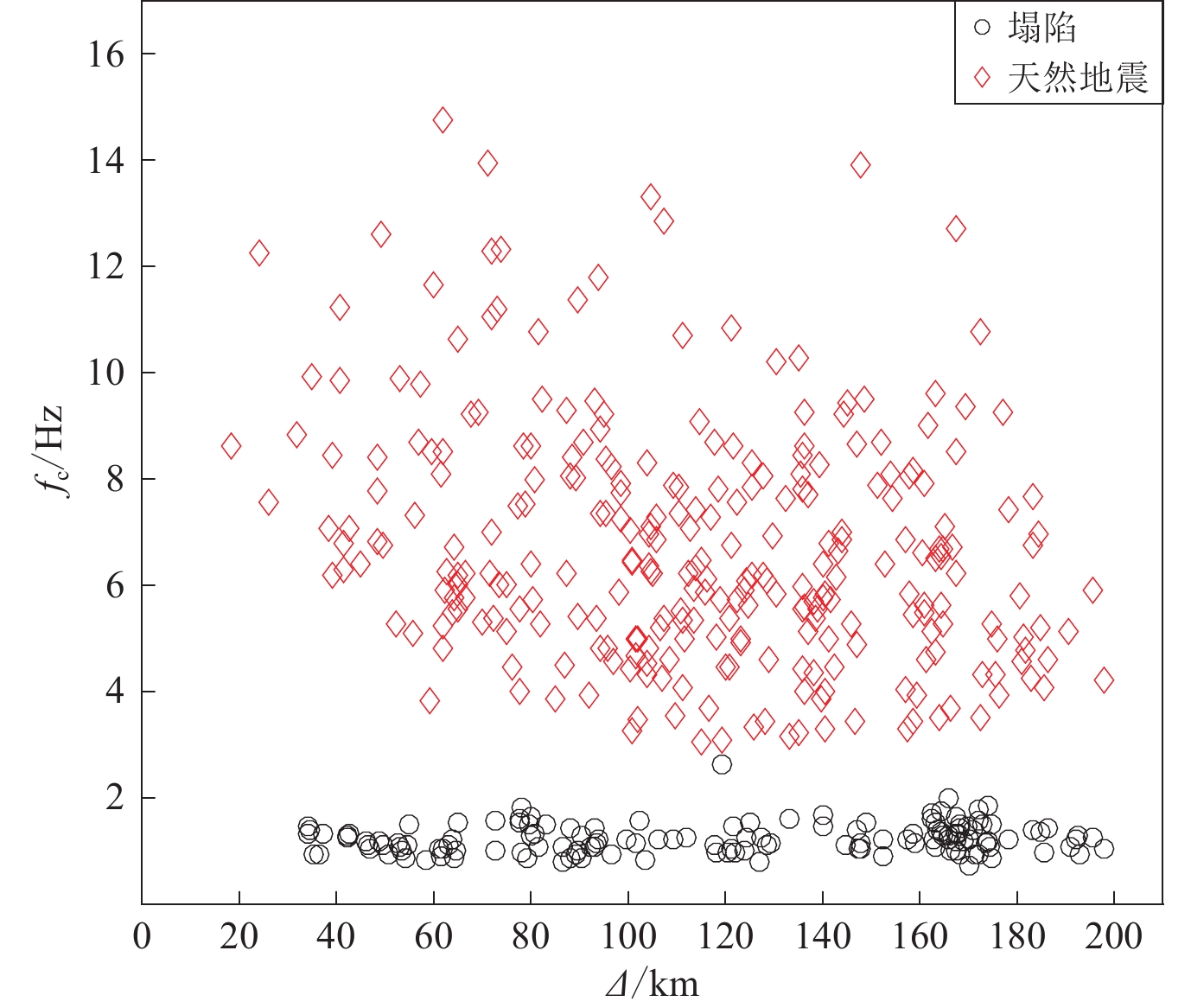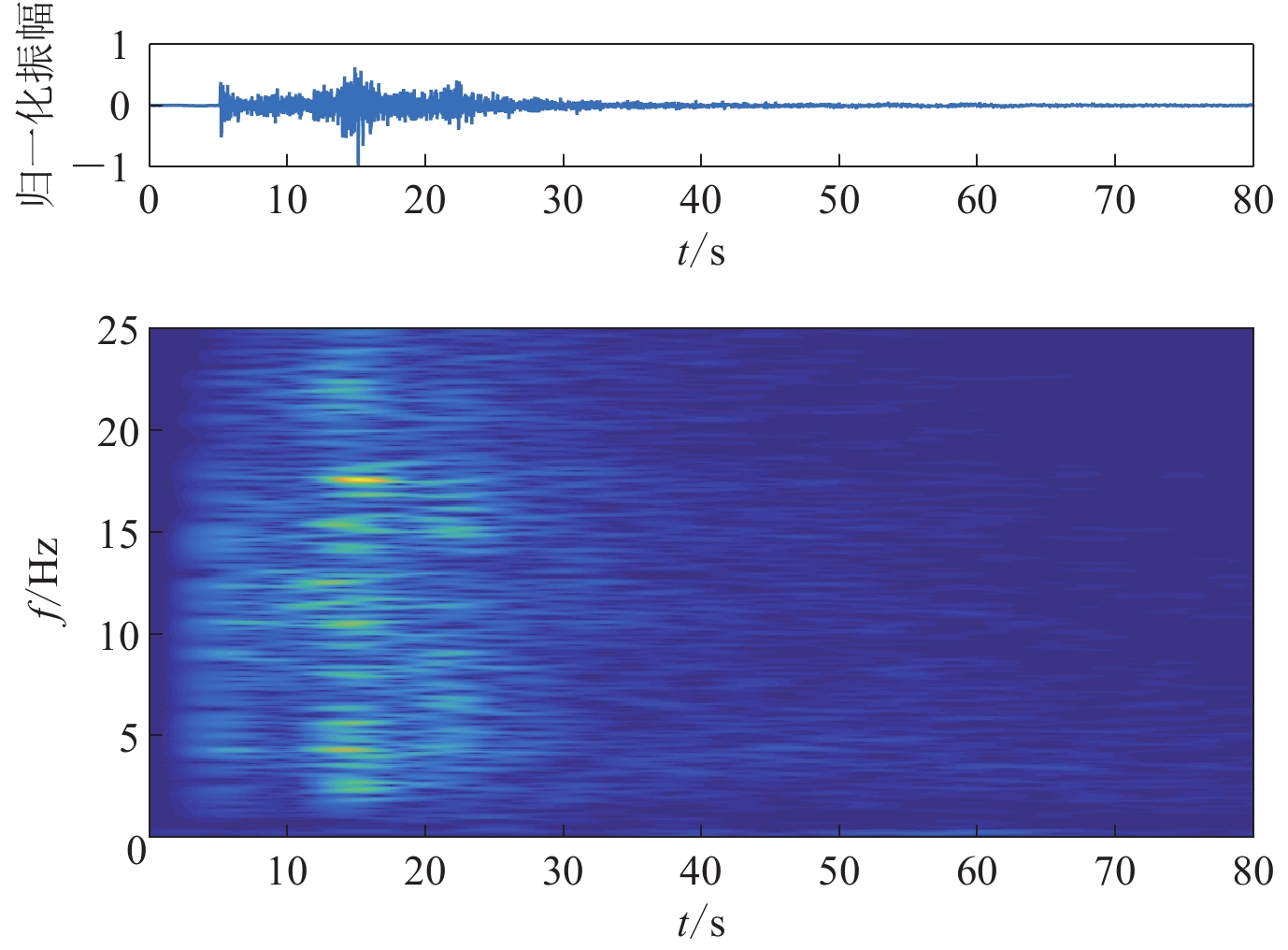Study on the regional characteristics of the subsidence seismic records in the northern Shaanxi
-
摘要: 选取陕西省境内2011—2018年震级为ML2.7—3.1的18个天然地震事件的287条记录和2013—2018年上述震级范围的20个陕北塌陷事件的185条记录,从时间域、频率域及时频域进行分析对比,总结出陕北塌陷记录区别于天然地震事件的特征:① 在时间域,就P波初动而言,塌陷的P波初动弱而平缓,只有极少数台的垂直向P波初动方向清晰,而天然地震的P波初动强而尖锐,垂直向P波初动方向清晰,有象限分布的特征;在体波特征方面,塌陷的体波周期要比天然地震的大;面波发育是塌陷区别于天然地震最显著的特征之一,即使震中距很小,塌陷记录依然有明显的短周期面波Rg波发育;在震中距<50 km时,塌陷的振幅比AS/AP值要远远大于天然地震,且随着震中距的增大,AS/AP值变小并与相同震中距下天然地震的AS/AP值相近;相同震级,塌陷比天然地震尾波持续时间长,能量衰减慢。② 在频率域,塌陷的频率域较窄,主要为低频信号,集中在0—3 Hz内;天然地震的频率域较宽,低频信号较少;定义频带内频谱的方差与均值的比值为频谱变异系数α,塌陷的频谱变异系数α整体高于天然地震的。在震中距200 km范围内,塌陷的拐角频率fc较天然地震小,集中在1—3 Hz,天然地震的拐角频率fc在3—15 Hz均有分布。③ 从时频谱的对比可见,塌陷的主要频率成份为低频面波,而天然地震频率成份最丰富的为横波波段。Abstract: This paper selects 287 records of 18 natural earthquake events with magnitudes of ML2.7—3.1 in Shaanxi Province from 2011 to 2018 and 185 records of 20 subsidence seismic events in northern Shaanxi with the same magnitude range from 2013 to 2018. Through the analysis and comparison in time and frequency and time-frequency domain, the characteristics of subsidence seismic records in the northern Shaanxi different from natural earthquake events are summarized as follows: ① In the time domain, the P-wave initial motion of subsidence is weak and gentle, while that of natural earthquake is strong and sharp. To the subsidence, only a few vertical direction of P-wave initial motions are clear, while that of natural earthquake is clear, and it has the characteristics of quadrant distribution. The body wave period of the subsidence is larger than the natural earthquake. The development of surface wave is one of the most significant characteristics that could distinguish subsidence from natural earthquake. Even if the epicenter distance is very small, subsidence seismic records still have significant short-period surface wave Rg. When the epicenter distance is less than 50 km, the amplitude ratio value AS/AP of subsidence is larger than that of natural earthquake. With the increase of epicenter distance, the amplitude ratio value AS/AP of subsidence becomes smaller and similar to that of earthquake under the same epicenter distance. With the same magnitude, the subsidence has a longer coda duration and slower energy decay than that of the earthquake. ② In the frequency domain, the frequency domain of subsidence is narrower, mainly low frequency signal, concentrated in 0−3 Hz. The frequency domain of the natural earthquake is wider, but the low frequency signal is less. The ratio of spectral variance to the mean in the frequency band was defined as the spectral difference coefficient α, and the α of the subsidence is generally higher than that of the natural earthquake. In the range of epicenter distance 200 km, corner frequency fc of the subsidence is smaller than that of the natural earthquake. Corner frequency fc of the subsidence is concentrated in 1−3 Hz, while fc of the natural earthquake is distributed in 3−15 Hz. ③ From the comparison of the time-frequency spectrum, it can be seen that the main frequency component of the subsidence is low-frequency surface waves, and the natural earthquake frequency component is most abundant in the shear wave band.
-
Keywords:
- subsidence /
- natural earthquake /
- time domain /
- frequency domain /
- time-frequency domain
-
-
图 2 塌陷和天然地震波形图
(a) YULG台记录的陕西榆阳塌陷 (2015−01−25 20:21:28.1,ML2.8,Δ=79.79 km);(b) ZOZT台记录的陕西宁陕天然地震 (2016−10−03 06:59:12.2,ML2.8,Δ=78.34 km);(c) YAAN台记录的陕西榆阳塌陷 (2015−01−25 20:21:28.1,ML3.0,Δ=171.86 km);(d) YAAN台记录的陕西洛川天然地震 (2017−11−25 23:08:56.8,ML2.7,Δ=109.12 km)
Figure 2. Surface wave of collapses and earthquakes
(a) Collapse in Yuyang,Shaanxi,recorded by YULG station (2015−01−25 20:21:28.1,ML2.8,Δ=79.79 km);(b) Earthquake in Ningshan,Shaanxi,recorded by ZOZT station (2016−10−03 06:59:12.2,ML2.8,Δ=78.34 km);(c) Collapse in Yuyang,Shaanxi,recorded by YAAN station (2015−01−25 20:21:28.1,ML3.0,Δ=171.86 km);(d) Earthquake in Luochuan,Shaanxi,recorded by YAAN station (2017−11−25 23:08:56.8,ML2.7,Δ=109.12 km)
图 5 塌陷与天然地震的频谱分布图
(a) YULG台记录的陕西榆阳塌陷 (2015−01−25 20:21:28.1,ML2.8,Δ=79.79 km);(b) ZOZT台记录的陕西宁陕天然地震 (2016−10−03 06:59:12.2,ML2.8,Δ=78.34 km)
Figure 5. The spectrum distribution of collapse and earthquake
(a) Collapse in Yuyang,Shaanxi,recorded by YULG station (2015−01−25 20:21:28.1,ML2.8,Δ=79.79 km);(b) Earthquake in Ningshan,Shaanxi,recorded by ZOZT station (2016−10−03 06:59:12.2,ML2.8,Δ=78.34 km)
图 7 塌陷与天然地震的P波段(红色波段)的频谱图及拐角频率fc
(a) ZZH台记录的陕西神木塌陷 (2015−08−24 08:33:05.8,ML2.8,Δ=165.82 km);(b) NSHT台记录的陕西乾县天然地震 (2017−11−19 15:11:22.0,ML2.7,Δ=142.7 km)
Figure 7. P-band (red band) spectrum and corner frequency of the collapse and earthquake
(a) Collapse in Shenmu,Shaanxi,recorded by ZZH station (2015−08−24 08:33:05.8,ML2.8,Δ=165.82 km);(b) Earthquake in Qianxian,Shaanxi,recorded by NSHT station (2017−11−19 15:11:22.0,ML2.7,Δ=142.7 km)
表 1 塌陷参数表
Table 1 Parameter table of the collapses
序号 发震时间 震中 ML 序号 发震时间 震中 ML 年−月−日 时:分:秒 北纬/° 东经/° 年−月−日 时:分:秒 北纬/° 东经/° 1 2013−12−19 08:49:20.9 38.59 110.42 2.9 11 2016−01−06 14:38:41.7 38.48 110.26 2.8 2 2014−04−09 11:00:08.1 39.09 110.42 3.1 12 2016−01−14 07:17:20.3 38.59 110.34 2.8 3 2014−11−29 18:21:18.3 39.03 110.19 2.8 13 2016−08−16 02:19:39.8 39.02 110.17 2.7 4 2014−04−09 19:57:10.4 39.11 110.42 2.8 14 2016−09−16 16:44:19.5 38.59 110.16 3.1 5 2015−08−24 08:33:05.8 39.04 110.22 2.7 15 2016−01−13 21:42:18.6 38.58 110.35 3.0 6 2015−06−28 15:27:43.9 39.15 110.30 2.7 16 2017−02−01 07:53:20.1 39.01 110.22 2.7 7 2015−11−28 09:16:27.4 39.04 110.32 2.8 17 2017−08−31 07:25:00.5 38.23 109.53 3.0 8 2015−01−25 20:21:28.1 38.21 109.51 2.9 18 2017−07−04 10:07:07.8 38.52 110.38 3.0 9 2015−02−21 13:33:13.4 39.01 110.38 2.9 19 2017−10−22 14:18:06.7 39.01 110.26 3.0 10 2015−07−09 20:09:14.9 38.27 109.55 3.1 20 2017−04−17 01:33:31.0 39.04 110.20 3.1 表 2 天然地震参数表
Table 2 Parameter table of the earthquakes
序号 发震时间 震中 ML 序号 发震时间 震中 ML 年−月−日 时:分:秒 北纬/° 东经/° 年−月−日 时:分:秒 北纬/° 东经/° 1 2011−02−08 12:58:03.9 32.58 106.12 3.1 10 2014−02−16 10:21:18.4 34.38 109.00 2.9 2 2011−06−21 16:02:20.1 33.14 109.27 3.1 11 2014−07−16 03:54:13.6 35.02 110.12 2.8 3 2011−06−21 20:47:28.6 33.13 109.26 2.8 12 2015−02−11 20:32:58.9 34.07 108.46 2.7 4 2012−06−16 04:59:25.0 35.06 108.11 3.0 13 2015−12−13 07:55:49.2 34.30 108.56 3.1 5 2013−03−16 22:21:40.4 34.07 108.31 3.0 14 2015−05−29 18:48:54.8 32.57 106.19 2.7 6 2013−09−11 01:46:48.7 34.43 109.58 2.7 15 2016−10−03 06:59:12.2 33.22 108.05 3.0 7 2013−08−04 02:47:57.8 33.11 108.27 2.7 16 2017−11−19 15:11:22.0 34.37 108.14 2.9 8 2013−02−25 10:23:50.1 34.10 108.31 3.0 17 2017−11−25 23:08:56.8 35.55 109.38 2.8 9 2013−11−29 20:52:13.5 32.46 105.37 2.8 18 2018−02−05 05:57:13.4 35.06 110.18 2.9 -
毕明霞,黄汉明,边银菊,李锐,陈银燕,赵静. 2011. 天然地震与人工爆破波形信号HHT特征提取和SVM识别研究[J]. 地球物理学进展,26(4):1157–1164. doi: 10.3969/j.issn.1004-2903.2011.04.004 Bi M X,Huang H M,Bian Y J,Li R,Chen Y Y,Zhao J. 2011. A study on seismic signal HHT features extraction and SVM recognition of earthquake and explosion[J]. Progress in Geophysics,26(4):1157–1164 (in Chinese).
曹肃朝. 1993. 构造地震和塌陷地震的特征分析[J]. 华北地震科学,11(1):52–61. Cao S C. 1993. Analysis of the characteristics of tectonic earthquakes and collapse earthquakes[J]. North China Earthquake Sciences,11(1):52–61 (in Chinese).
陈丽娟,陈学忠,李艳娥,王生文,郭祥云. 2015. 利用纵、横波的拐角频率比值和位移谱零频极限比值计算波速比:以芦山MS7.0地震序列为例[J]. 地震,35(2):11–25. doi: 10.3969/j.issn.1000-3274.2015.02.002 Chen L J,Chen X Z,Li Y E,Wang S W,Guo X Y. 2015. Calculating wave velocity ratio vP/vS of the 2013 Lushan earthquake sequence from source spectrum parameters[J]. Earthquake,35(2):11–25 (in Chinese).
崔鑫,许力生,许忠淮,李铂,王峰. 2016. 小地震与人工爆破记录的时频分析[J]. 地震工程学报,38(1):71–78. doi: 10.3969/j.issn.1000-0844.2016.01.0071 Cui X,Xu L S,Xu Z H,Li B,Wang F. 2016. Time-frequency analysis of records of small earthquakes and explosions[J]. China Earthquake Engineering Journal,38(1):71–78 (in Chinese).
狄莉莎,陈俊华. 2007. 长江三峡地区巴东野三关地震成因探讨[J]. 大地测量与地球动力学,27(专刊):62–66. Di L S,Chen J H. 2007. On genesis of Yesanguan micro-earthquakes in Three Gorges area on Yangtze River[J]. Journal of Geodesy and Geodynamics,27(S):62–66.
狄秀玲,王平,金昭娣,王建昌. 2009. 陕西榆林地区北部塌陷地震初步分析[J]. 灾害学,24(4):81–83. Di X L,Wang P,Jin Z D,Wang J C. 2009. Preliminary analysis on collapse earthquakes in northern Yulin,Shaanxi Province[J]. Journal of Catastrophology,24(4):81–83 (in Chinese).
狄秀玲,王平,刘伟. 2011. 通过地震编目分析陕西省地震分布[J]. 通过地震编目分析陕西省地震分布,32(5):140–142. Di X L,Wang P,Liu W. 2011. Analysis on distribution of earthquakes in Shaanxi Province through catalog earthquake[J]. Seismological and Geomagnetic Observation and Research,32(5):140–142 (in Chinese).
董建华,顾汉明,张星. 2007. 几种时频分析方法的比较及应用[J]. 工程地球物理学报,4(4):312–316. doi: 10.3969/j.issn.1672-7940.2007.04.009 Dong J H,Gu H M,Zhang X. 2007. A comparison of time-frequency analysis methods and their applications[J]. Chinese Journal of Engineering Geophysics,4(4):312–316 (in Chinese).
董星宏,韩恒悦,邵辉成,王新,李永辉. 2005. 对陕西榆林地区三次矿震灾害的认识[J]. 灾害学,20(2):96–98. doi: 10.3969/j.issn.1000-811X.2005.02.021 Dong X H,Han H Y,Shao H C,Wang X,Li Y H. 2005. Cognition of three mine quake disasters in Yulin,Shaanxi[J]. Journal of Catastrophology,20(2):96–98 (in Chinese).
黄汉明,边银菊,卢正军,蒋正锋,李锐. 2010. 天然地震与人工爆破的波形小波特征研究[J]. 地震学报,32(3):270–276. doi: 10.3969/j.issn.0253-3782.2010.03.002 Huang H M,Bian Y J,Lu Z J,Jiang Z F,Li R. 2010. A wavelet feature research on seismic waveforms of earthquakes and explosions[J]. Acta Seismologica Sinica,32(3):270–276 (in Chinese).
黄世源,魏红梅,高见,刘云. 2017. 重庆数字地震记录人工爆破波形特征[J]. 华北地震科学,35(2):30–33. doi: 10.3969/j.issn.1003-1375.2017.02.005 Huang S Y,Wei H M,Gao J,Liu Y. 2017. Wave characteristics of blasting events recorded by the Chongqing digital seismic network[J]. North China Earthquake Sciences,35(2):30–33 (in Chinese).
惠少兴,严川,王平,金昭娣. 2018. 陕西地区小微震震源机制研究[J]. 地震工程学报,40(2):288–293. Hui S X,Yan C,Wang P,Jin Z D. 2018. Research on focal mechanisms of the small and micro earthquakes in Shaanxi area[J]. China Earthquake Engineering Journal,40(2):288–293 (in Chinese).
林怀存,王保平,刘洪瑞,姜久坤. 1990. 构造地震与塌陷地震对比分析[J]. 地震学报,12(4):448–455. Lin H C,Wang B P,Liu H R,Jiang J K. 1990. Comparative study of tectonic and collapse earthquakes[J]. Acta Seismologica Sinica,12(4):448–455 (in Chinese).
刘海燕,田刚,石战结. 2015. 几种时频分析方法的比较和实际应用[J]. CT理论与应用研究,24(2):199–208. Liu H Y,Tian G,Shi Z J. 2015. The comparison of time-frequency analysis methods and their applications[J]. Computerized Tomography Theory and Applications,24(2):199–208 (in Chinese).
刘莎,杨建思,田宝峰,郑钰,姜旭东,徐志强. 2012. 首都圈地区爆破、矿塌和天然地震的识别研究[J]. 地震学报,34(2):202–214. doi: 10.3969/j.issn.0253-3782.2012.02.007 Liu S,Yang J S,Tian B F,Zheng Y,Jiang X D,Xu Z Q. 2012. Discrimination between explosions,mine collapses and earthquakes in capital region of China[J]. Acta Seismologica Sinica,34(2):202–214 (in Chinese).
邵辉成,罗词建. 2009. 陕北煤矿塌陷及灾害简介[J]. 华北地震科学,27(2):1–4. doi: 10.3969/j.issn.1003-1375.2009.02.001 Shao H C,Luo C J. 2009. A brief introduction to coal mine collapse and disaster in northern Shaanxi[J]. North China Earthquake Sciences,27(2):1–4 (in Chinese).
唐兰兰,王海涛. 2009. 爆破与地震的波谱特征分析[J]. 内陆地震,23(3):377–385. doi: 10.3969/j.issn.1001-8956.2009.03.009 Tang L L,Wang H T. 2009. Spectrum characteristics analysis of explosions and earthquakes[J]. Inland Earthquake,23(3):377–385 (in Chinese).
汪贵章,凌学书,张佑龙,戚浩,夏仕安,吴辉. 2010. 安徽及周边爆破塌陷特殊地震动特征识别[J]. 防灾科技学院学报,12(2):26–31. doi: 10.3969/j.issn.1673-8047.2010.02.007 Wang G Z,Ling X S,Zhang Y L,Qi H,Xia S A,Wu H. 2010. Characteristic recognition of non-natural earthquakes such asexplosions in Anhui and the periphery[J]. Journal of Institute of Disaster-Prevention Science and Technology,12(2):26–31 (in Chinese).
王惠琳,李志雄,徐晓枫,孙佩雯. 2017. 琼北确定性人工爆破与天然地震识别判据[J]. 地震地磁观测与研究,38(4):74–80. doi: 10.3969/j.issn.1003-3246.2017.04.013 Wang H L,Li Z X,Xu X F,Sun P W. 2017. Discrimination criterions of doubtless explosions and earthquakes in northern Hainan area[J]. Seismological and Geomagnetic Observation and Research,38(4):74–80 (in Chinese).
王平,惠少兴,狄秀玲,赵韬. 2014. 陕西区域地震目录最小完整性震级研究[J]. 震灾防御技术,9(增刊):702–708. Wang P,Hui S X,Di X L,Zhao T. 2014. The analysis of minimum magnitude of completeness of Shaanxi earthquake catalogues[J]. Technology for Earthquake Disaster Prevention,9(S):702–708 (in Chinese).
王婷婷,边银菊. 2011. 识别天然地震和人工爆破的判据选择[J]. 地震地磁观测与研究,32(6):62–67. doi: 10.3969/j.issn.1003-3246.2011.06.012 Wang T T,Bian Y J. 2011. Criterion selection of earthquake and explosion recognition[J]. Seismological and Geomagnetic Observation and Research,32(6):62–67 (in Chinese).
王婷婷,边银菊,张博. 2013. 地震和爆破的综合识别方法研究[J]. 地球物理学进展,28(5):2433–2443. doi: 10.6038/pg20130522 Wang T T,Bian Y J,Zhang B. 2013. The comprehensive identification methods between earthquakes and explosions[J]. Progress in Geophysics,28(5):2433–2443 (in Chinese).
杨成荣,王桂岭,敖雪明. 2001. 乌鲁木齐附近地区小爆破识别判据的研究[J]. 内陆地震,15(1):30–38. doi: 10.3969/j.issn.1001-8956.2001.01.004 Yang C R,Wang G L,Ao X M. 2001. Study on identification criterion of small explosion in Urumqi’s neighbouring area[J]. Inland Earthquake,15(1):30–38 (in Chinese).
杨芳,朱嘉健,刘智,吴彬. 2016. 广东地区地震与爆破事件识别方法研究[J]. 华南地震,36(3):110–115. Yang F,Zhu J J,Liu Z,Wu B. 2016. Study on identification methods between earthquakes and explosions occurred in Guangdong region[J]. South China Journal of Seismology,36(3):110–115 (in Chinese).
曾宪伟,赵卫明,李鸿庭,师海阔,姚琳. 2010. 利用小波包变换时频谱识别宁夏及邻区的地震和爆破[J]. 地震研究,33(3):300–307. doi: 10.3969/j.issn.1000-0666.2010.03.010 Zeng X W,Zhao W M,Li H T,Shi H K,Yao L. 2010. Discrimination between earthquakes and explosions in Ningxia and its neighboring region using time-frequency spectrum wavelet packet transform[J]. Journal of Seismological Research,33(3):300–307 (in Chinese).
张丽芬,姚运生,李井冈,吴海波. 2013. 三峡库区构造和塌陷地震的拐角频率特征[J]. 大地测量与地球动力学,33(2):27–30. Zhang L F,Yao Y S,Li J G,Wu H B. 2013. Corner frequency characteristic of tectonic earthquakes and collapsed ones in Three Gorges region[J]. Journal of Geodesy and Geodynamics,33(2):27–30 (in Chinese).
张萍,魏富胜,潘科,边银菊,蒋秀琴. 2009. 爆破与地震的拐角频率比较[J]. 地震地磁观测与研究,30(5):20–25. Zhang P,Wei F S,Pan K,Bian Y J,Jiang X Q. 2009. Comparison of corner frequency between explosion and earthquake[J]. Seismological and Geomagnetic Observation and Research,30(5):20–25 (in Chinese).
赵永,刘卫红,高艳玲. 1995. 北京地区地震、爆破和矿震的记录图识别[J]. 地震地磁观测与研究,16(4):48–54. Zhao Y,Liu W H,Gao Y L. 1995. Distinguish in earthquake,explosion and mine earthquake in Beijing area[J]. Seismological and Geomagnetic Observation and Research,16(4):48–54 (in Chinese).
郑秀芬,傅瑀,许绍燮. 2006. 地震记录中小爆破的识别与判据研究[J]. 地震地磁观测与研究,27(5):29–33. doi: 10.3969/j.issn.1003-3246.2006.05.006 Zheng X F,Fu Y,Xu S X. 2006. The discrimination and criteria study between blasts and small earthquakes[J]. Seismological and Geomagnetic Observation and Research,27(5):29–33 (in Chinese).
Brune J N. 1970. Tectonic stress and the spectra of seismic shear waves from earthquakes[J]. J Geophys Res,75(136):4997–5009.
Huang N E,Shen Z,Long S R,Wu M C,Shih H H,Zheng Q A,Yen N C,Tung C C,Liu H H. 1998. The empirical mode decomposition and the Hilbert spectrum for nonlinear and non-stationary time series analysis[J]. Proc Roy Soc London Math Phys Eng Sci,454(1971):903–995. doi: 10.1098/rspa.1998.0193
-
期刊类型引用(5)
1. 陆天然,段梦乔,李子怡,周连庆. 人工智能地震分类研究进展综述. 地球物理学进展. 2025(01): 25-47 .  百度学术
百度学术
2. 沈婕,朱景宝,缪发军,宋晋东,李山有. 基于残差神经网络的天然地震与非天然地震信号分类. 地震工程与工程振动. 2024(05): 13-25 .  百度学术
百度学术
3. 姬东姣,季灵运,古云鹤,张雪娟,史会忍,梁向东. 陕西榆神府矿区塌陷地震波形时频特征分析. 科技与创新. 2023(14): 32-35 .  百度学术
百度学术
4. 张玲,李丽. 2021年8月11日山西云冈M_L 3.0地震事件类型研究. 地震地磁观测与研究. 2023(03): 27-33 .  百度学术
百度学术
5. 梁皓,孙丽,陈姝荞,支明. 基于支持向量机算法的地震事件分类研究——以东北地区为例. 地球物理学报. 2023(12): 5030-5040 .  百度学术
百度学术
其他类型引用(1)




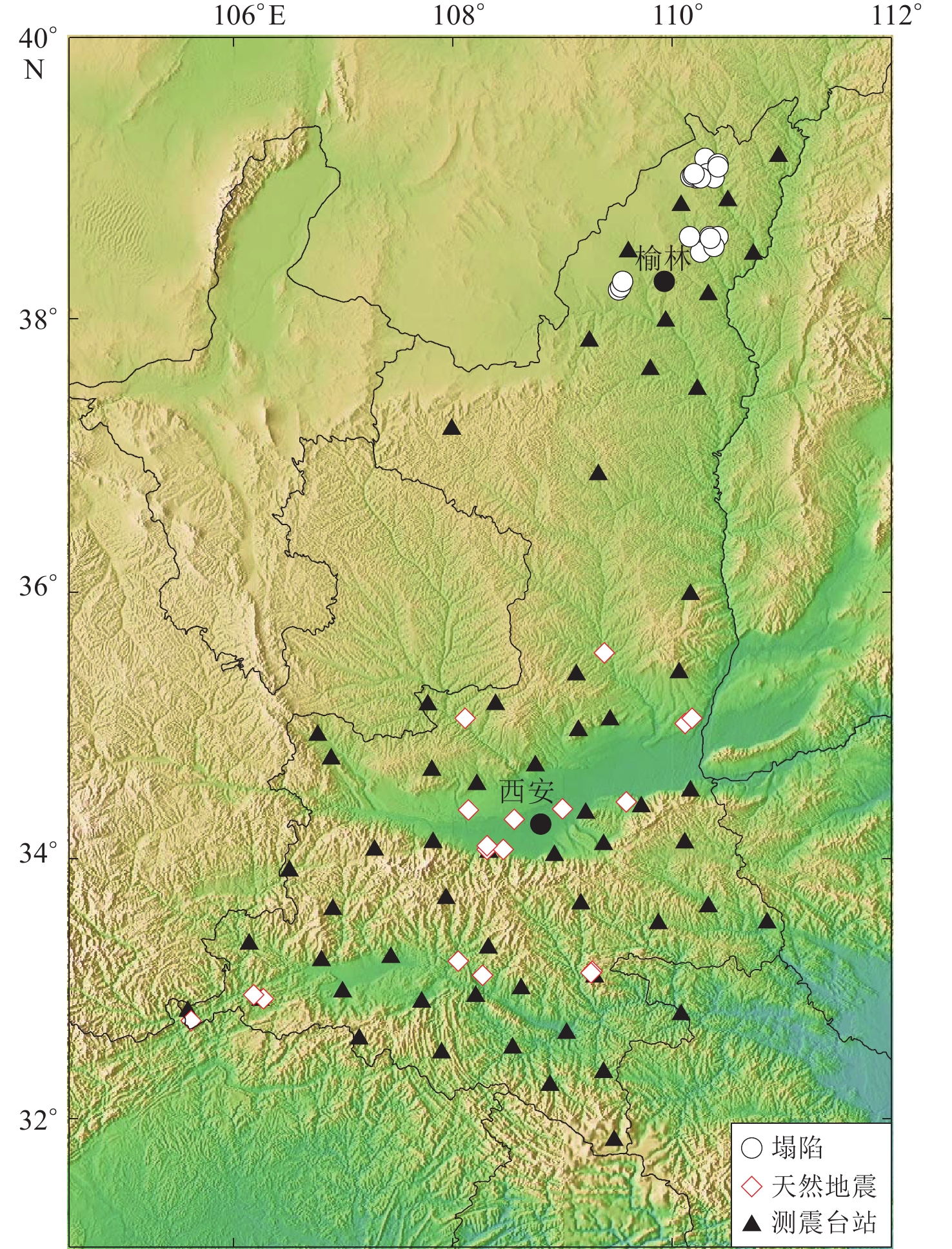
 下载:
下载:


